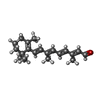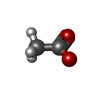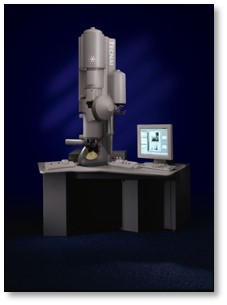+ Open data
Open data
- Basic information
Basic information
| Entry | Database: PDB / ID: 9ljj | ||||||
|---|---|---|---|---|---|---|---|
| Title | cryo-EM structure of a nanobody bound heliorhodopsin | ||||||
 Components Components |
| ||||||
 Keywords Keywords | MEMBRANE PROTEIN / bacterial rhodopsin | ||||||
| Function / homology | Heliorhodopsin / Heliorhodopsin / membrane / ACETATE ION / PALMITIC ACID / 1,2-DILAUROYL-SN-GLYCERO-3-PHOSPHATE / RETINAL / Heliorhodopsin Function and homology information Function and homology information | ||||||
| Biological species |   | ||||||
| Method | ELECTRON MICROSCOPY / single particle reconstruction / cryo EM / Resolution: 3.23 Å | ||||||
 Authors Authors | He, Y. / Xia, R. | ||||||
| Funding support |  China, 1items China, 1items
| ||||||
 Citation Citation |  Journal: Biochem Biophys Res Commun / Year: 2025 Journal: Biochem Biophys Res Commun / Year: 2025Title: Cryo-EM structure of a nanobody-bound heliorhodopsin. Authors: Ruixue Xia / Mingxia Sun / Yang Lu / Na Wang / Anqi Zhang / Changyou Guo / Zhenmei Xu / Xuehui Cai / Yuanzheng He /  Abstract: Heliorhodopsins (HeRs) represent a distinct class of microbial rhodopsins (MRs) with an inverted membrane topology compared to other MRs. Previous structural studies have shown that HeRs lack a ...Heliorhodopsins (HeRs) represent a distinct class of microbial rhodopsins (MRs) with an inverted membrane topology compared to other MRs. Previous structural studies have shown that HeRs lack a proton acceptor residue, and protons are never released from the protein. In this study, we present the cryo-electron microscopy (cryo-EM) structure of HeR bound to a nanobody. The structure reveals an acetate-like molecule in the Schiff base cavity (SBC) on the intracellular side of HeR under neutral condition. Structural comparisons and analyses suggest that the acetate molecule may function as a proton acceptor for the protonated retinal Schiff base (RSB) and act as a mediator for the intramolecular signaling transduction in HeR during light stimulation. These structural insights shed new light on the mechanism and function of HeR. | ||||||
| History |
|
- Structure visualization
Structure visualization
| Structure viewer | Molecule:  Molmil Molmil Jmol/JSmol Jmol/JSmol |
|---|
- Downloads & links
Downloads & links
- Download
Download
| PDBx/mmCIF format |  9ljj.cif.gz 9ljj.cif.gz | 136 KB | Display |  PDBx/mmCIF format PDBx/mmCIF format |
|---|---|---|---|---|
| PDB format |  pdb9ljj.ent.gz pdb9ljj.ent.gz | 106.4 KB | Display |  PDB format PDB format |
| PDBx/mmJSON format |  9ljj.json.gz 9ljj.json.gz | Tree view |  PDBx/mmJSON format PDBx/mmJSON format | |
| Others |  Other downloads Other downloads |
-Validation report
| Summary document |  9ljj_validation.pdf.gz 9ljj_validation.pdf.gz | 1.4 MB | Display |  wwPDB validaton report wwPDB validaton report |
|---|---|---|---|---|
| Full document |  9ljj_full_validation.pdf.gz 9ljj_full_validation.pdf.gz | 1.4 MB | Display | |
| Data in XML |  9ljj_validation.xml.gz 9ljj_validation.xml.gz | 32.1 KB | Display | |
| Data in CIF |  9ljj_validation.cif.gz 9ljj_validation.cif.gz | 44.3 KB | Display | |
| Arichive directory |  https://data.pdbj.org/pub/pdb/validation_reports/lj/9ljj https://data.pdbj.org/pub/pdb/validation_reports/lj/9ljj ftp://data.pdbj.org/pub/pdb/validation_reports/lj/9ljj ftp://data.pdbj.org/pub/pdb/validation_reports/lj/9ljj | HTTPS FTP |
-Related structure data
| Related structure data |  63157MC M: map data used to model this data C: citing same article ( |
|---|---|
| Similar structure data | Similarity search - Function & homology  F&H Search F&H Search |
- Links
Links
- Assembly
Assembly
| Deposited unit | 
|
|---|---|
| 1 |
|
- Components
Components
-Protein / Antibody , 2 types, 4 molecules ABMN
| #1: Protein | Mass: 28026.078 Da / Num. of mol.: 2 Source method: isolated from a genetically manipulated source Details: Sequence reference for source organism Escherichia coli is not available in UniProt at the time of biocuration. Current sequence reference is from UniProt id A0A2R4S913. Source: (gene. exp.)   #2: Antibody | Mass: 13289.878 Da / Num. of mol.: 2 Source method: isolated from a genetically manipulated source Source: (gene. exp.)   |
|---|
-Non-polymers , 4 types, 8 molecules 






| #3: Chemical | | #4: Chemical | #5: Chemical | ChemComp-PX2 / | #6: Chemical | |
|---|
-Details
| Has ligand of interest | N |
|---|---|
| Has protein modification | Y |
-Experimental details
-Experiment
| Experiment | Method: ELECTRON MICROSCOPY |
|---|---|
| EM experiment | Aggregation state: PARTICLE / 3D reconstruction method: single particle reconstruction |
- Sample preparation
Sample preparation
| Component | Name: dimer complex / Type: COMPLEX / Entity ID: #1-#2 / Source: RECOMBINANT |
|---|---|
| Molecular weight | Experimental value: NO |
| Source (natural) | Organism:  |
| Source (recombinant) | Organism:  |
| Buffer solution | pH: 7 |
| Specimen | Embedding applied: NO / Shadowing applied: NO / Staining applied: NO / Vitrification applied: YES |
| Vitrification | Cryogen name: ETHANE |
- Electron microscopy imaging
Electron microscopy imaging
| Experimental equipment |  Model: Tecnai F30 / Image courtesy: FEI Company |
|---|---|
| Microscopy | Model: FEI TECNAI F30 |
| Electron gun | Electron source:  FIELD EMISSION GUN / Accelerating voltage: 300 kV / Illumination mode: FLOOD BEAM FIELD EMISSION GUN / Accelerating voltage: 300 kV / Illumination mode: FLOOD BEAM |
| Electron lens | Mode: BRIGHT FIELD / Nominal defocus max: 2200 nm / Nominal defocus min: 1200 nm |
| Image recording | Electron dose: 60 e/Å2 / Film or detector model: GATAN K2 SUMMIT (4k x 4k) |
- Processing
Processing
| EM software | Name: PHENIX / Version: 1.18.2_3874 / Category: model refinement |
|---|---|
| CTF correction | Type: NONE |
| 3D reconstruction | Resolution: 3.23 Å / Resolution method: FSC 0.143 CUT-OFF / Num. of particles: 239778 / Symmetry type: POINT |
 Movie
Movie Controller
Controller



 PDBj
PDBj













